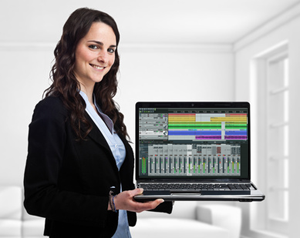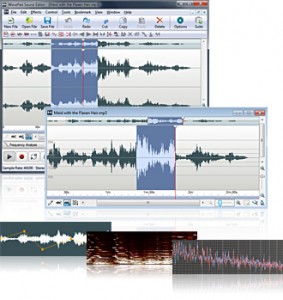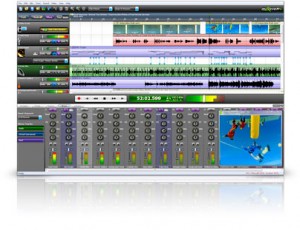 I just received a question through the Home Brew Audio YouTube channel (http://www.youtube.com/user/homebrewaudio) about recording vocals at home.
I just received a question through the Home Brew Audio YouTube channel (http://www.youtube.com/user/homebrewaudio) about recording vocals at home.
This person doesn’t understand why when they sing loud into the mic in their home recording studio, the sound comes out distorted. Here’s this person’s question and our answer:
Q: well what I’m trying to understand is why I can’t sing as loud as I like… I recorded in a studio a few times, and i could sing as loud as I like, and similar things, however now the trimming affect works and the software break the voice into a horrible annoying sound… so sorry I don’t know how to describe it any better.
I connect my mic to a little boxy thing that my dad bought with it, called M-Audio (ed: he probably means the M-Audio Fast Track) that connects to my computer through USB.
Thanks alot, Dave :]
A: Dave, I know exactly what you mean. You have two options. The best one is to get a compressor and/or limiter, and connect it to the M-Audio box (Fast Track is it?). A compressor will lower your voice loudness when it starts getting loud, and a limiter will prevent it crossing a certain loudness level entirely. You would use the “insert” sockets on the back of the box. I use a great little compressor called the Really Nice Compressor (I’m not kidding:)), by a company called FMR audio. There are lots of different kinds out there though.
The second way is to back way away from the mic for the loud bits. If the entire song is loud, turn the “gain” knob down until the loudest parts don’t clip (make the red light on the M-Audio box go on), and then raise the level of the recorded wave after the fact. The problem there though is that it might let more noise in along with your voice, which you would then be turning up at that last stage.
I hope that helps!
Ken
note: Dave is not the real name of the person who asked the question. We changed it for privacy reasons.
Archives for July 2011
Waves Audio, Phil Manchester & Griff Comm Ltd. Launch New Audio Forensics Package
Cool uses of audio other than what we normally think of –
Recently, leading covert audio specialist Phil Manchester & Griff Comm Ltd in collaboration with Waves Audio announced release of latest audio forensics package to help law enforcement agencies investigations. In fact, this made possible only through use of Waves audio tools to provide critical audio evidence for a prosecution case against plot to kill a British Muslim soldier and bring culprits to justice. On other hand, Phil Manchester is only full-time covert audio specialist in UK, solved more than 700 criminal cases involving national-level criminal offenses. In fact, some of its specialists involved in solving many criminal level investigations.
Read the full article here:
Waves Audio, Phil Manchester & Griff Comm Ltd. Launch New Audio Forensics Package
Level 3 Master Class Training Session With Alan Parsons In Los Angeles
Multi-Platinum engineer, produce, and artist Alan Parsons is hosting a workshop on professional audio mixing. The live tracking session is being held in Los Angeles on July 22nd to the 23th in Los Angeles. Attendees observe and participate in all aspects of the recording session. They will get to work along side some of LA’s top musicians. At the end of the workshop, the attendees will take home the mix of the track.
Read the full article here:
Level 3 Master Class Training Session With Alan Parsons In Los Angeles
Voice Recording Software – What You Should Use
 The term voice recording software, especially in the context of recording voice overs, is actually sort of a misleading term. That’s because pretty much any software that is designed for recording on a computer is going to be just as capable of recording the human voice as any other audio. So the real question, becomes something more like “what else other than voice recording will I need to do with a particular audio recording program?”
The term voice recording software, especially in the context of recording voice overs, is actually sort of a misleading term. That’s because pretty much any software that is designed for recording on a computer is going to be just as capable of recording the human voice as any other audio. So the real question, becomes something more like “what else other than voice recording will I need to do with a particular audio recording program?”
Let’s take an example. Many folks use a free recording program called Audacity, which is pretty darned amazing for a piece of free-ware. If all you ever really want to do is record your voice to do introductions for your own programs, videos or podcasts, Audacity is likely to be the only audio software you’ll ever need. It has the ability to record at high resolution, do basic edits and produce professional sounding audio.
If, on the other hand, you also want to record music, especially involving multiple tracks or in-depth and intuitive editing, Audacity probably isn’t your best choice. Once you get beyond the basic “push-record/stop/play” functions, Audacity loses out on simplicity and capability. It becomes worth your time and money at that point to use two programs, one designed for recording and mixing, and the other designed for editing and finishing/producing.
It may seem counter-intuitive, but think of it this way. It is ultimately better for your workflow, not only physically but mentally as well, if you can compartmentalize discrete tasks, especially when the software being

used is specifically designed for that purpose. The more focused the reason for a program, the faster and more intuitive it tends to be for users. In my case, I use a program called Reaper (by Cockos), for recording and mixing, then I use another program called Adobe Audition for editing and final production. This workflow is so natural to me that even if I need to record a quick voice over job, I open Reaper to do the recording, then I double-click on the audio item on the track to automatically open my editing program, Audition. I can then quickly reduce ambient noise, fix p-pops, even out and optimize volume, and save as any format I want.

Now obviously these are not the only two programs out there you can use for this kind of work-flow. You could use Reaper + Audacity, for example. There are also some really affordable, intuitive and powerful new-comers, such as Mixcraft 8 for recording and mixing. And if you need more capability or better workflow than Audacity can provide, a really good (and much more affordable than Audition) alternative is WavePad Sound Editor.
So basically it comes down to this. Any recording program is going to be at least as good at recording voice as it is at recording anything else, so don’t worry about looking for voice recording software so much as something more generic, like audio recording software. At that point, you just have to know what capabilities you’ll need. Extremely basic voice over jobs, like for your YouTube videos or podcasts, can be handled by something like Audacity. But if you want to ad any capability beyond that, the best choice is to divide and conquer with two programs working together, one for recording and mixing, and the other for editing and final production.
The Overlooked (And Vital) Variables Of Recording
Professional Sounding Audio – Here is a great article from ProSound once again.
It seems like if the gear is not vintage, a name brand or high priced, it’s automatically shunned, but the major variables that go into making a good recording always lie in other places than the gear itself.
— The Player and the instrument contributes about 50 percent to the overall sound.
Get a player who’s not yet that accomplished and record him with his equipment.
Chances are it will sound pretty mediocre.
Placement is really your acoustic EQ and is responsible for the instrument’s blend in the track.
Read the full article here: